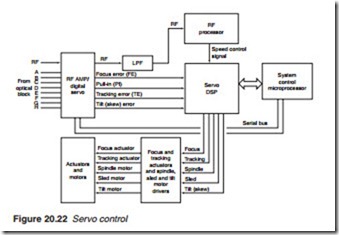The RF processor
The RF processor has two major tasks: signal processing and disc speed control. For this reason, this chip is also known as RF processor/digital servo chip (Figure 20.19). These tasks must be carried out for DVD/HD DVD as well as audio-CD applications. The input to the RF processor is a high-frequency waveform known as the RF signal. It is generated by the optical head as it reads the pits and lands on the surface of the disc. The waveform is an analogue format representing a digital bitstream. Since it is not repetitive, it cannot be observed on an analogue oscillo- scope. On a storage digital oscilloscope, the waveform will be as shown in Figure 20.20. If observed on an analogue oscilloscope, the pattern shown in Figure 20.21 will be displayed. This pattern, known as the RF eye pat- tern, is generated because the 8/16 (EFM+) modulation results in restrict- ing the number of ones or zeros that can follow in a sequence.
The frequency of the pattern is determined by the closeness, i.e. size of a pit. For blue-laser-based discs, the pit size is small and hence the pattern
has a higher frequency requiring an oscilloscope with a minimum band- width of 100 MHz compared with that produced by a red-laser-based DVD disc which can do with a bandwidth of 40 MHz. Before processing can take place, the incoming analogue signal from the RF amplifier is con- verted into a digital format by the ADC. This is followed by the RF proces- sor unit to produce a digital bitstream which is used for signal processing and spindle speed control. The bitstream from the RF processing unit contains 16-bit words which are converted back into their original 8 bits by the EFM/EFM (8/16) demodulator. This is followed by recording sector detection, error correction and RF data processing. For DVD, HD DVD and BD, the bitstream is de-crypted to re-produce the original program
stream for DVD/HD DVD or the transport stream or the BD. Audio CD data streams do not require de-crypting and thus they are fed directly into the next stage. The bitstream from the RF processor unit is also fed into a CLV controller which monitors the bit rate to determine the linear speed of the disc and a signal is sent to the servo controller to change the speed of spindle motor as appropriate.

